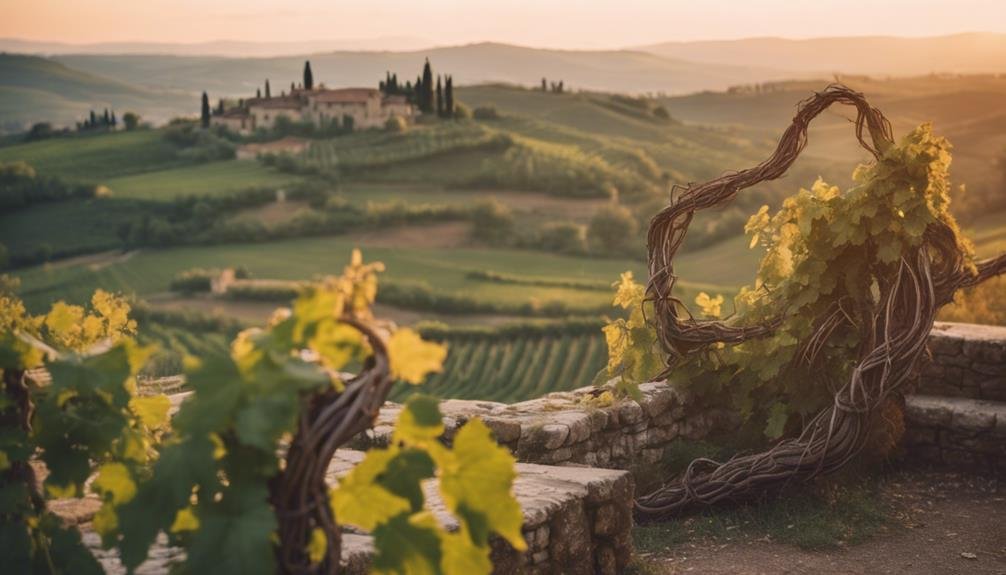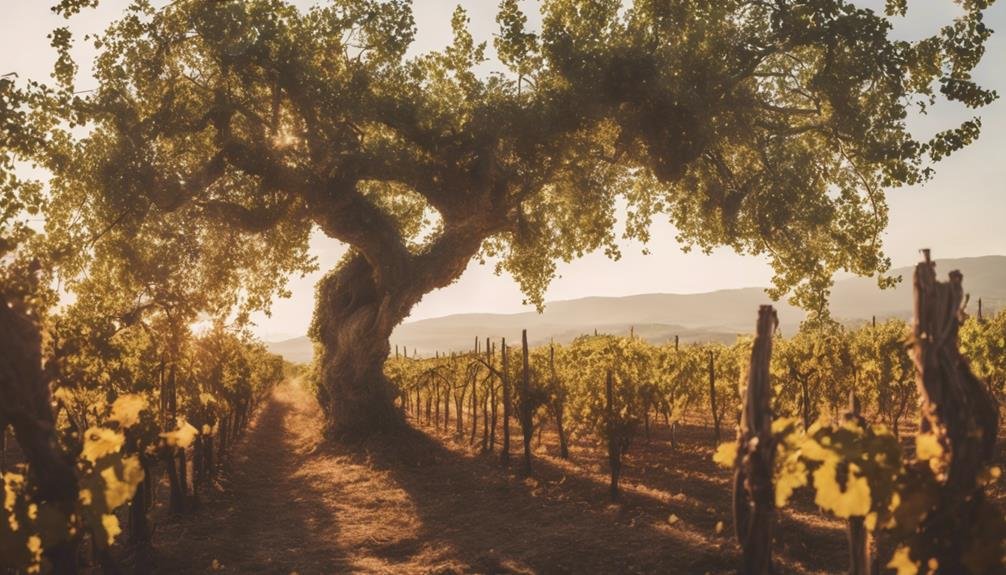Aged vines harbor a treasure trove of wine secrets, with deep roots accessing nutrients and imparting resilience. They withstand challenges, absorbing minerals to produce wines with intense flavors and complexity, a proof of years of nurture showing wisdom and patience. Mature vineyards amplify flavors and sustainability, offering consistent quality and supporting biodiversity. Prominent regions like Lodi, Southern France, Barossa Valley, and Santorini showcase unique grape varieties and practices. These historical vineyards preserve traditions, cultural heritage, and terroir, reflecting a deep connection spanning generations. Discover the hidden charms of aged vines, steeped in heritage and flavor.
Characteristics of Aged Vines
Amidst the world of winemaking, the characteristics of aged vines serve as proof of the intricate relationship between vine age and the quality of the fruit they produce. These vines exhibit deep-rooted resilience, allowing them to access nutrients from beneath the surface, resulting in concentrated elegance in the fruit they bear.
The roots of older vines reach deeply into the soil, providing a stability that younger vines may lack. This depth enables the vine to withstand environmental stresses and absorb essential minerals, contributing to the intense flavors and complexity found in wines produced from mature vineyards.
The concentrated elegance found in wines crafted from aged vines is a demonstration of the wisdom and patience required to nurture these exceptional grapevines.
Benefits of Mature Vineyards
The rich legacy of aged vines extends into mature vineyards, showcasing a plethora of benefits that elevate the quality and sustainability of winemaking practices. Mature vineyards offer enhanced flavors and contribute to sustainable practices in the following ways:
| Benefits of Mature Vineyards | |
|---|---|
| Enhanced Flavors | Mature vineyards produce grapes that result in wines with richer and more complex flavors due to the depth of the roots and concentrated fruit. |
| Sustainable Practices | These vineyards require less water and chemical inputs, promoting environmental sustainability. Their deep-rooted vines also contribute to soil health and reduce erosion. |
| Consistent Quality | Older vines consistently reach peak ripeness, ensuring a high standard of quality in the wines produced. |
| Biodiversity Support | Mature vineyards help support biodiversity by providing habitats for various plant and animal species. |
Notable Old Vineyard Regions

In the world of wine production, certain regions stand out for their exceptional old vineyards and unique grape varieties. Lodi, California is renowned for its Zinfandel vines, showcasing the rich flavors that old vines can produce.
Southern France's Languedoc region boasts exceptional Carignan wines, reflecting the region's vineyard practices and dedication to preserving heritage.
Barossa Valley in Australia is an Old Vine Charter region, highlighting the significance of vine age in winemaking.
Santorini, Greece, is famous for its Assyrtiko grape, used in Nykteri wine, showcasing the unique varietals found in the region.
Each of these regions not only emphasizes unique grape varieties but also implements distinctive vineyard practices, contributing to the exceptional quality of their wines.
Historical Significance and Old Vines
Preserving historical vineyard practices, old vines offer a unique glimpse into the rich tapestry of winemaking traditions. Old vines contribute to the terroir exploration, showcasing the deep-rooted history of a region's winemaking heritage. However, the preservation challenges faced by growers include reduced yields and lower market value compared to younger vineyards. Despite these obstacles, the historical significance of old vines cannot be overstated. To illustrate this further, consider the following table:
| Historical Significance of Old Vines | |
|---|---|
| – Offers insight into traditional vineyard practices | – Preserves unique terroir |
| – Maintains cultural heritage | – Challenges in preservation |
| – Timeless quality and value | – Balancing tradition with modern practices |
Through the cultivation and conservation of old vines, winemakers navigate the delicate balance between honoring the past and embracing innovation in the ever-evolving world of viticulture.
Cultural Impact of Aging Vineyards

Cultivating aging vineyards nurtures a rich tapestry of cultural heritage in the world of viticulture. These vineyards embody centuries-old traditions, preserving unique grape varieties that hold historical significance.
The cultural heritage embedded in aging vineyards extends beyond winemaking practices; it reflects a deep connection to the land and the generations of winemakers who have tended to these vines. Additionally, the environmental sustainability of aging vineyards is paramount, as they support biodiversity and contribute to soil health.
Frequently Asked Questions
How Do Old Vines Contribute to the Unique Terroir of a Region?
Old vines contribute uniquely to terroir through deep roots, accessing diverse soil nutrients, enriching grape quality. Historical vineyard practices and traditional winemaking techniques shape the character of wines, reflecting the essence of the region.
What Are the Challenges Faced by Growers Maintaining Old Vineyards?
Maintaining old vineyards presents challenges in sustainability and innovation. Growers face balancing tradition with modern technology. Reduced production impacts income, while the need for preservation competes with market demands. Sustainability practices are essential for preserving these historical vineyards.
Are There Any Unique Grape Varieties Exclusively Found in Old Vineyards?
Unique grape varieties exclusive to old vineyards showcase rare grapes like Trousseau in Jura, France. These ancient vines produce distinctive wines, embodying centuries of history and terroir. Their limited presence adds allure to wine enthusiasts worldwide.
How Do Old Vines Impact the Biodiversity of a Region?
Old vines play an essential role in enhancing ecosystem diversity by impacting soil and microorganism interactions. Their deep roots help maintain soil health, support diverse microbial communities, and contribute to the overall biodiversity of a region.
What Is the Economic Value of Preserving Old Vineyards Compared to Replanting?
Preserving old vineyards offers economic benefits through maintaining historical significance and cultural heritage. It supports biodiversity, enhances environmental impact, and upholds traditional winemaking practices. Balancing economic value with the preservation of old vines is essential for sustainable viticulture.
Conclusion
To sum up, the aged vines in the world of winemaking are like wise elders, sharing their rich secrets and stories through the flavors they produce. Their deep roots and reduced yields offer a glimpse into the past, enriching the present with a unique terroir that captivates enthusiasts.
As we savor these wines crafted from venerable vines, we not only taste history but also celebrate the resilience and tradition that have stood the test of time.
Cheers to the timeless allure of aged vine wines!